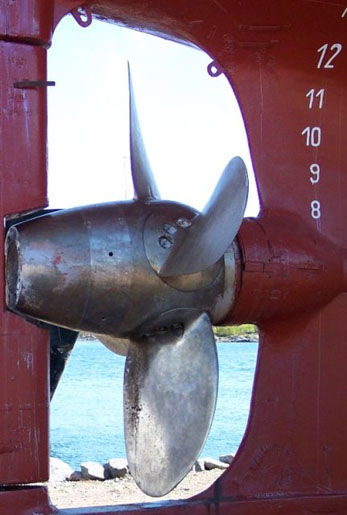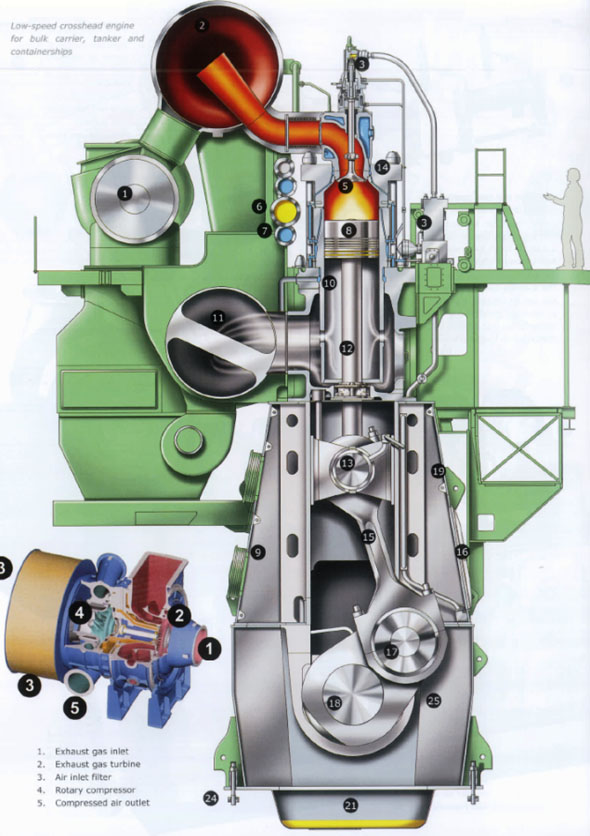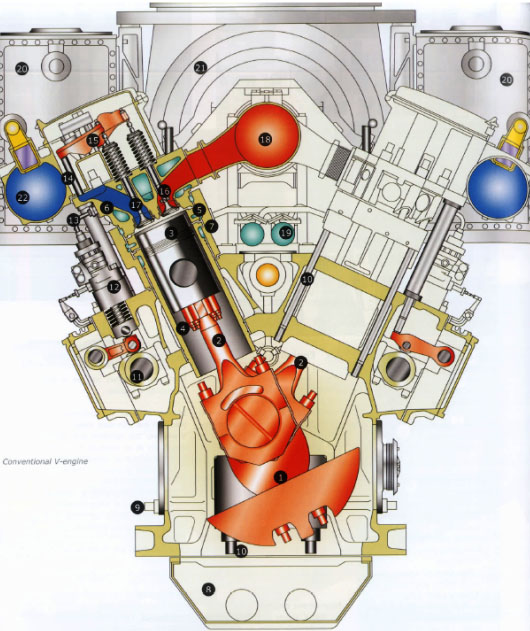Propellers. Shaft generators. Types of marine diesel engines.
Propellers. Shaft generators. Types of marine diesel engines.
Propeller screw
A normal vessel is propelled by propellers (not thrusters, steamer wheels, or water cannons). In the case of a cargo ship, when money is more important than maneuverability and high speed, there is usually one propeller.
Two or more propellers are installed on high-speed ships (passenger ships, ferries), custom-designed ships and when the total power of the ship's power plant is too large for one propeller.
 The propeller is driven by one or two motors through the propeller shaft. The propeller can be either fixed blades ( fixed pitch propeller , solid bronze) or rotary ( variable pitch propeller , CPP).
The propeller is driven by one or two motors through the propeller shaft. The propeller can be either fixed blades ( fixed pitch propeller , solid bronze) or rotary ( variable pitch propeller , CPP).
Fixed propellers are combined with a reversible motor (direct acting motor) or a reversing gearbox (usually on low power units). They are used on coasters (ships sailing offshore) and large boats with engines running at low rpm.
All other vessels are equipped with CPPs. The angle of attack of the blades, varied by the hydraulic mechanism, determines the speed of the vessel and the direction of its movement ("forward" or "backward").
Thus, for ships with a fixed propeller and a direct-acting engine (without a gearbox), switching to reverse is a whole thing, as they say in Odessa. It is necessary to turn off the main engine, and then start it in the opposite direction. And the engine sometimes lives its own life, it may not start right away. The ship is moored, the sailor stands ready at the anchor brake, the boatswain looks at the bridge with a raised hand.
In general, half of the broken berths are the result of such situations when the vessel failed to brake in time. The engine did not start, the anchor did not hold.
When using a shaft generator
Shaft generator - an electric generator that operates directly from the shaft of the main engine. The use of a shaft generator is beneficial - the resource of auxiliary engines is not wasted (all the money, money ...). Energy is generated while the ship is under way.
 As already mentioned, the speed of a ship with a CPP is regulated by the pitch of the propeller, and the main engine runs at about the same speed all the time. In this case, an electric generator installed on the shaft will generate a stable voltage and provide the ship with electricity.
As already mentioned, the speed of a ship with a CPP is regulated by the pitch of the propeller, and the main engine runs at about the same speed all the time. In this case, an electric generator installed on the shaft will generate a stable voltage and provide the ship with electricity.
In the case of a fixed propeller, the speed of the main motor (shaft speed) changes all the time, and a conventional shaft generator will not be able to maintain a stable voltage. Then the electric generators work from additional motors.
However, when using modern equipment (frequency converters), the shaft generator can also be used at a variable shaft speed, on ships with a fixed propeller.
Types of marine engines
Well, we finally got to the main ship engine. What are they, how do they differ from each other?

Marine diesel engines can be two-stroke (one combustion cycle takes two piston movements, up and down) and four-stroke (four movements). In two-stroke engines, the cylinders are always aligned (in-line engine). Four-stroke can be both in-line and V-shaped (two rows of cylinders at an angle to each other). The advantage of V-shaped engines is that they are half the length of an in-line engine with the same number of cylinders.

Inline engines have a maximum of 12 cylinders, V-engines up to 20.
According to the speed of rotation of the shaft, marine motors are divided into:
- high - speed four-stroke (revolutions over 960 rpm);
- medium - speed four-stroke (from 240 to 960 rpm);
- low-speed (low-speed) two-stroke (below 240 rpm).
Slow-speed motors can directly rotate the propeller, high- and medium-speed motors do this through a reduction gear.
High-speed engines are installed on small vessels - harbor tugs, coasters. Medium - speed - for various medium-sized vessels, sea tugs and vessels with limited height for the engine room (Ro-Ro, a vessel for the transport of goods "on wheels" - cars, wagons, etc.). A low-speed direct-action engine is usually installed on ships with a displacement of more than 30 thousand tons. The weight of such an engine can exceed a thousand tons, and the cylinder diameter is more than a meter!
This is where the advantage of high-speed motors lies. With the same shaft power, the dimensions and weight of such a motor are several times less than its low-speed counterpart. But there is a problem - such engines run only on expensive high-quality fuel. More about this in our next article.
 +7 (812) 4-673-673
+7 (812) 4-673-673